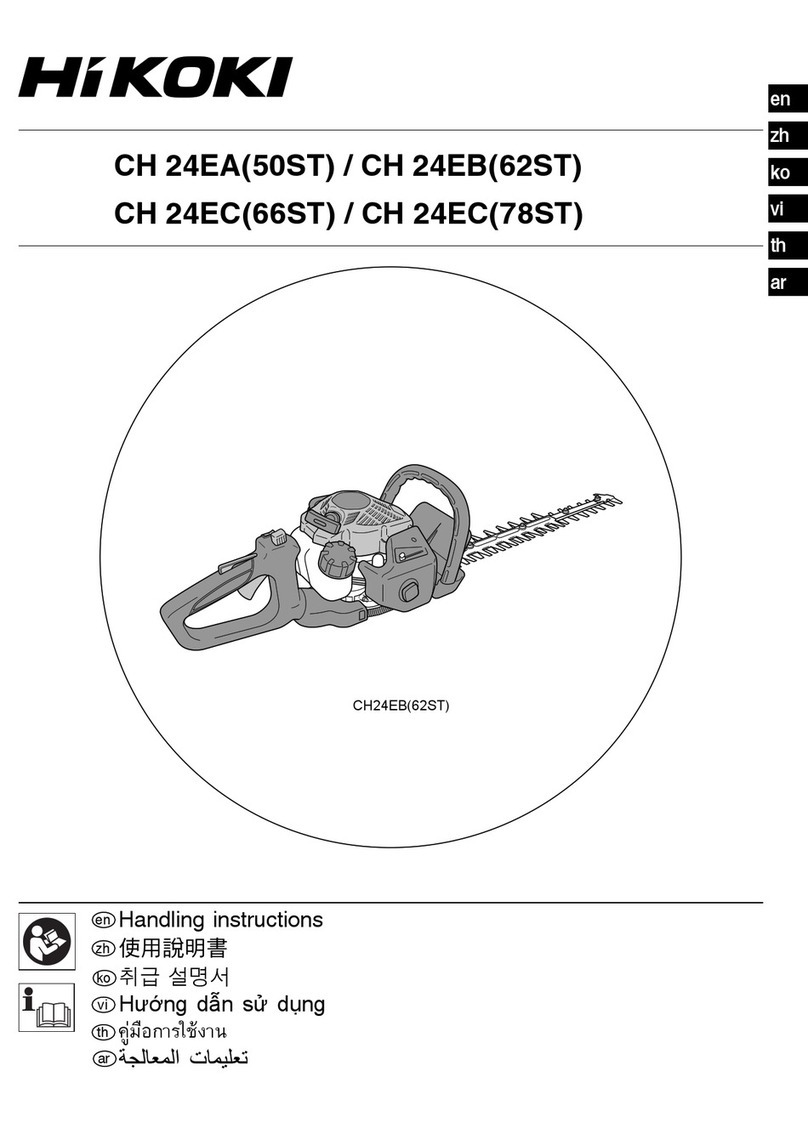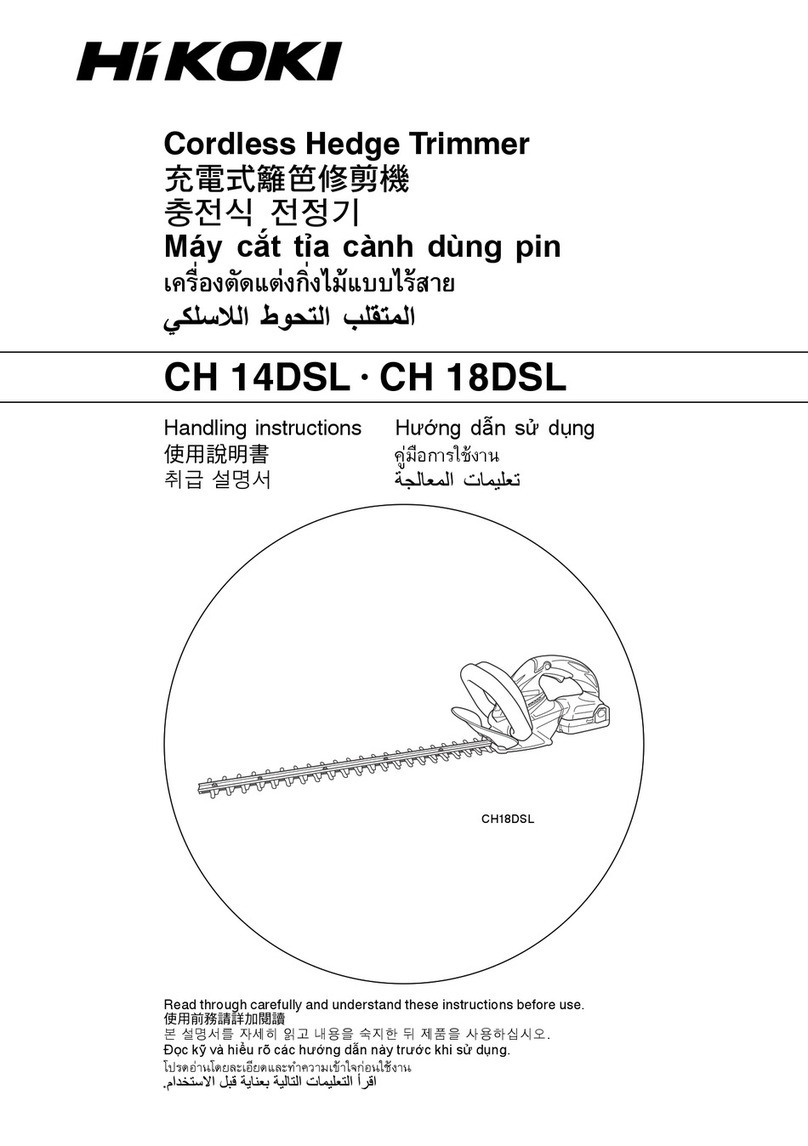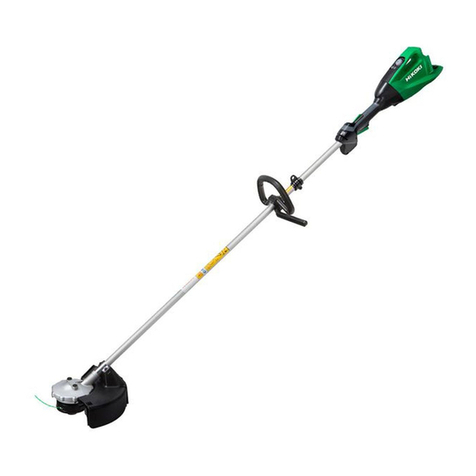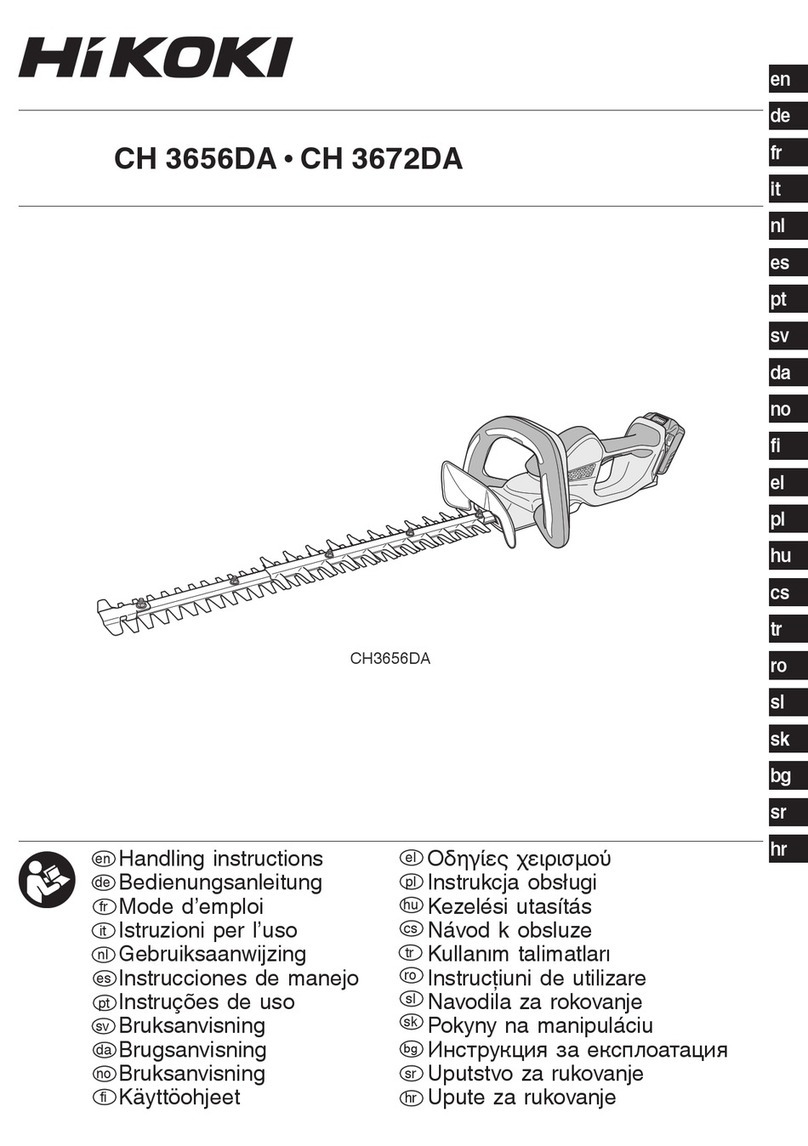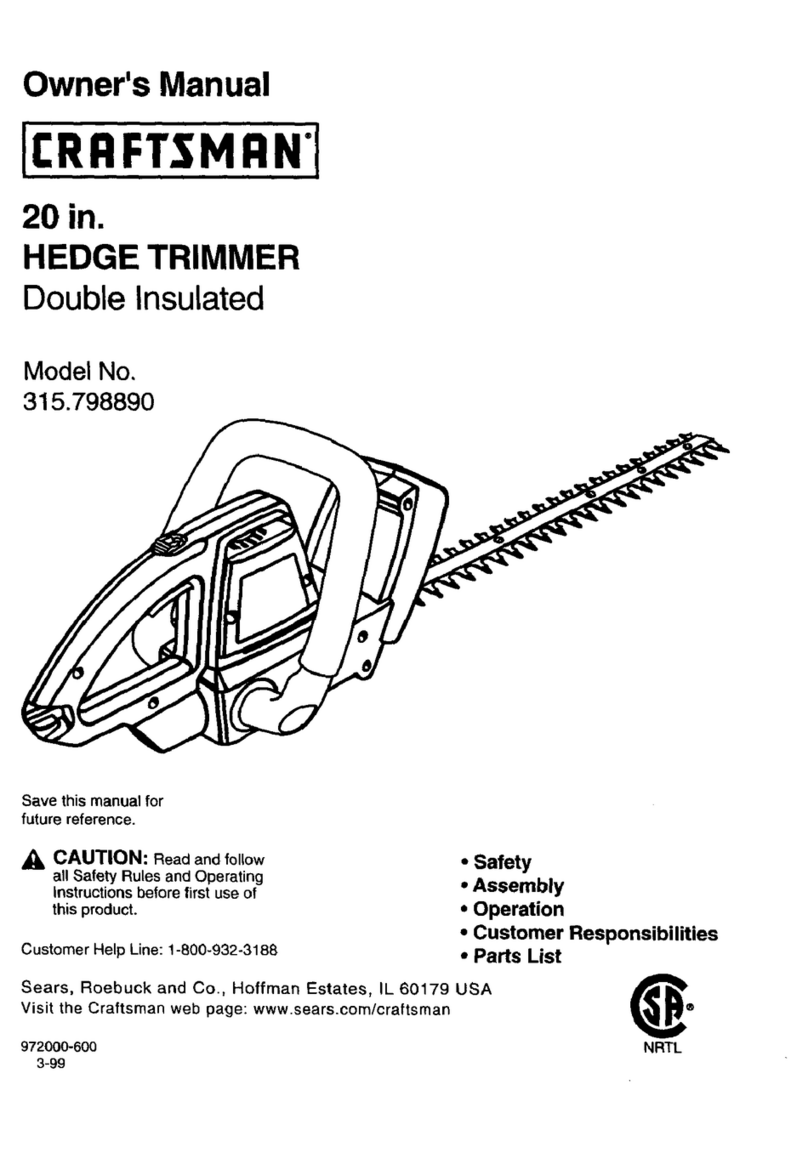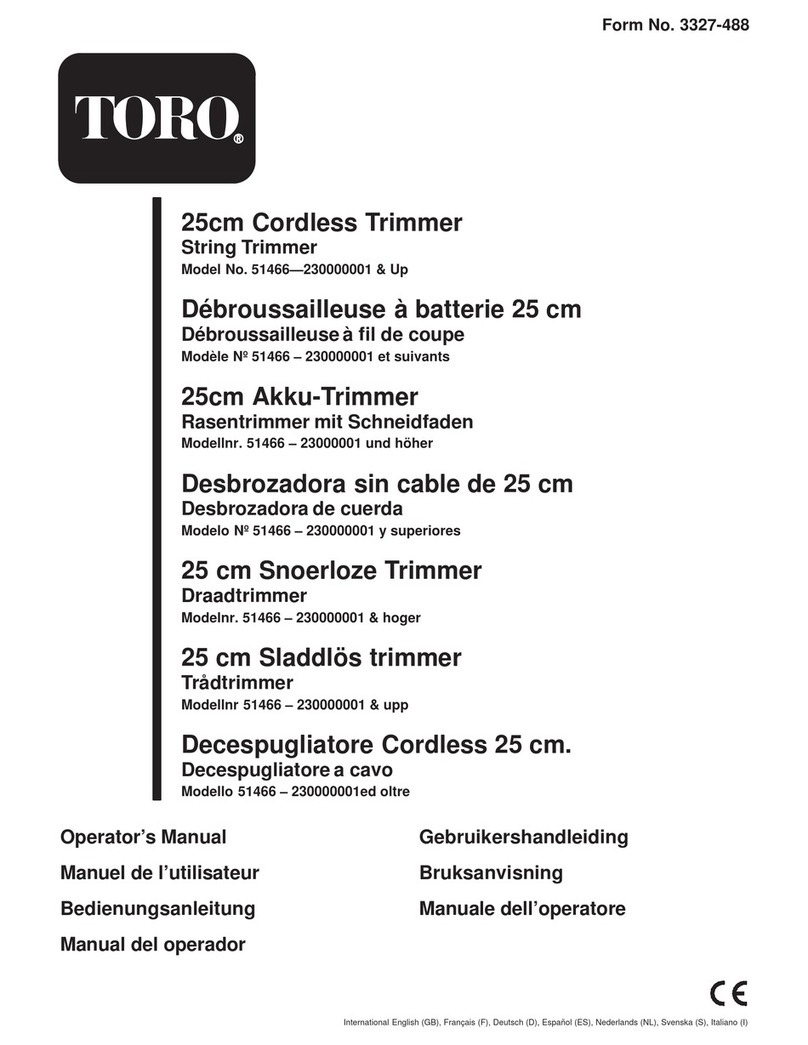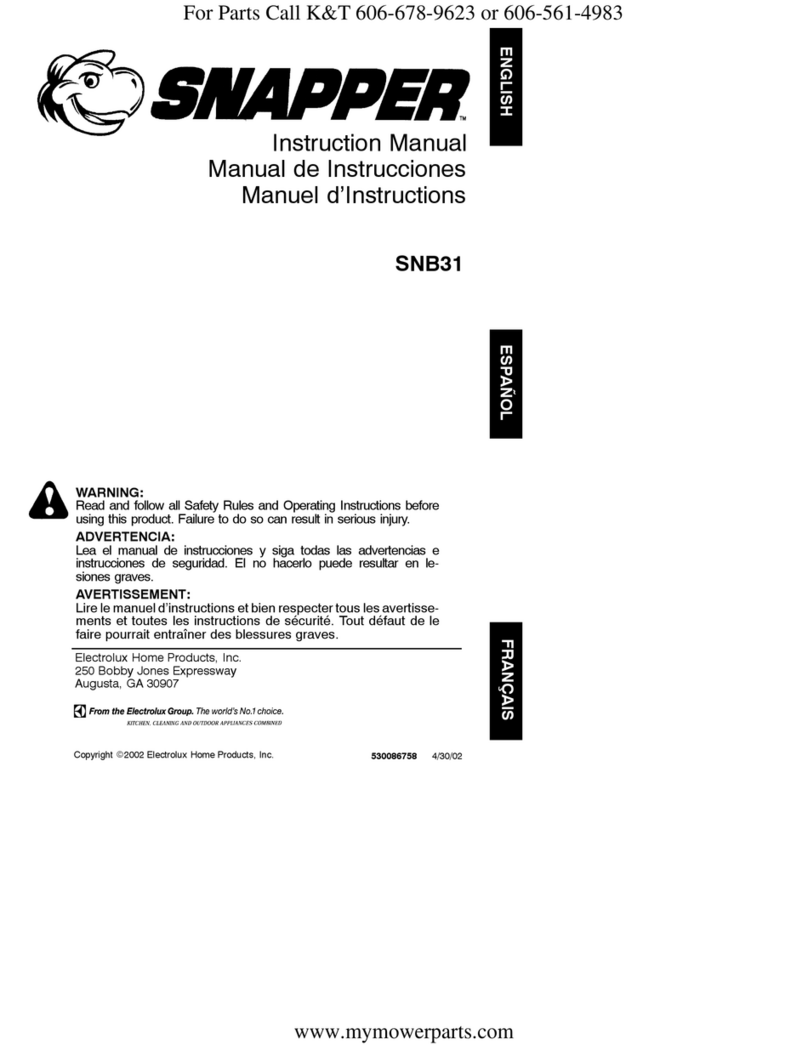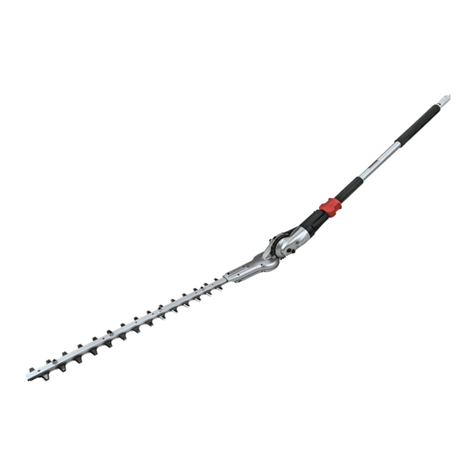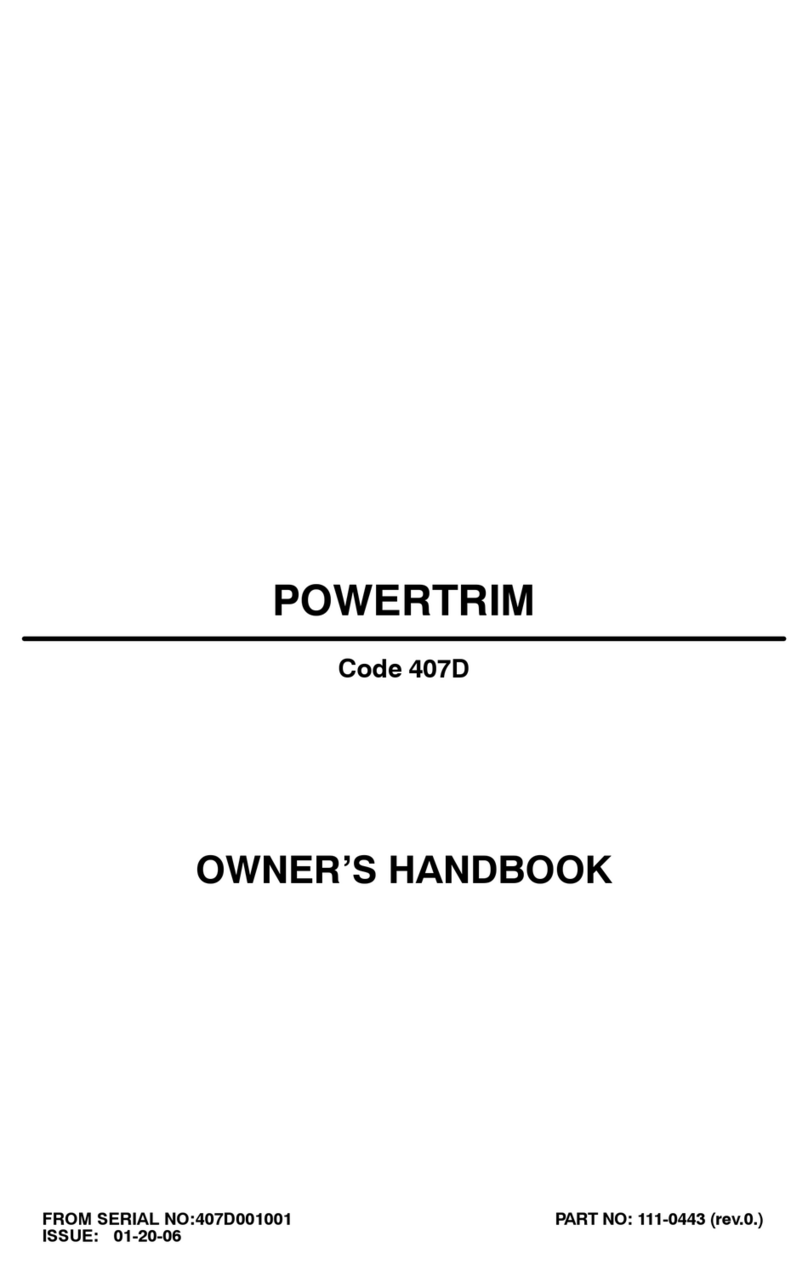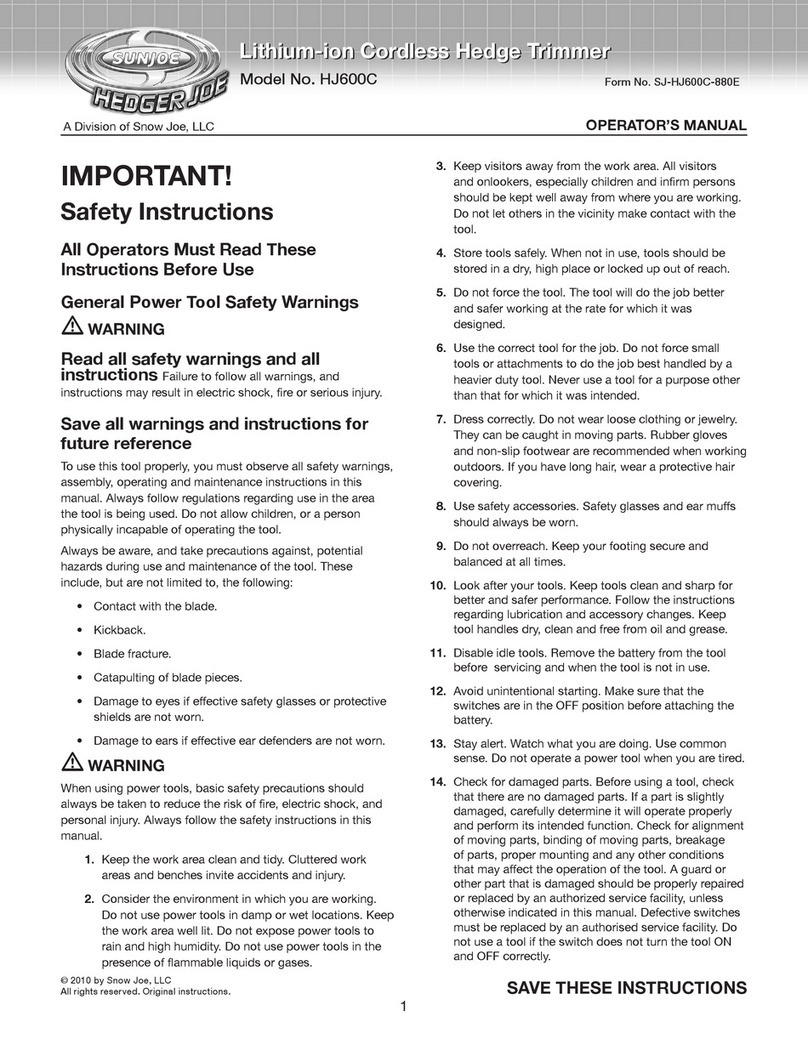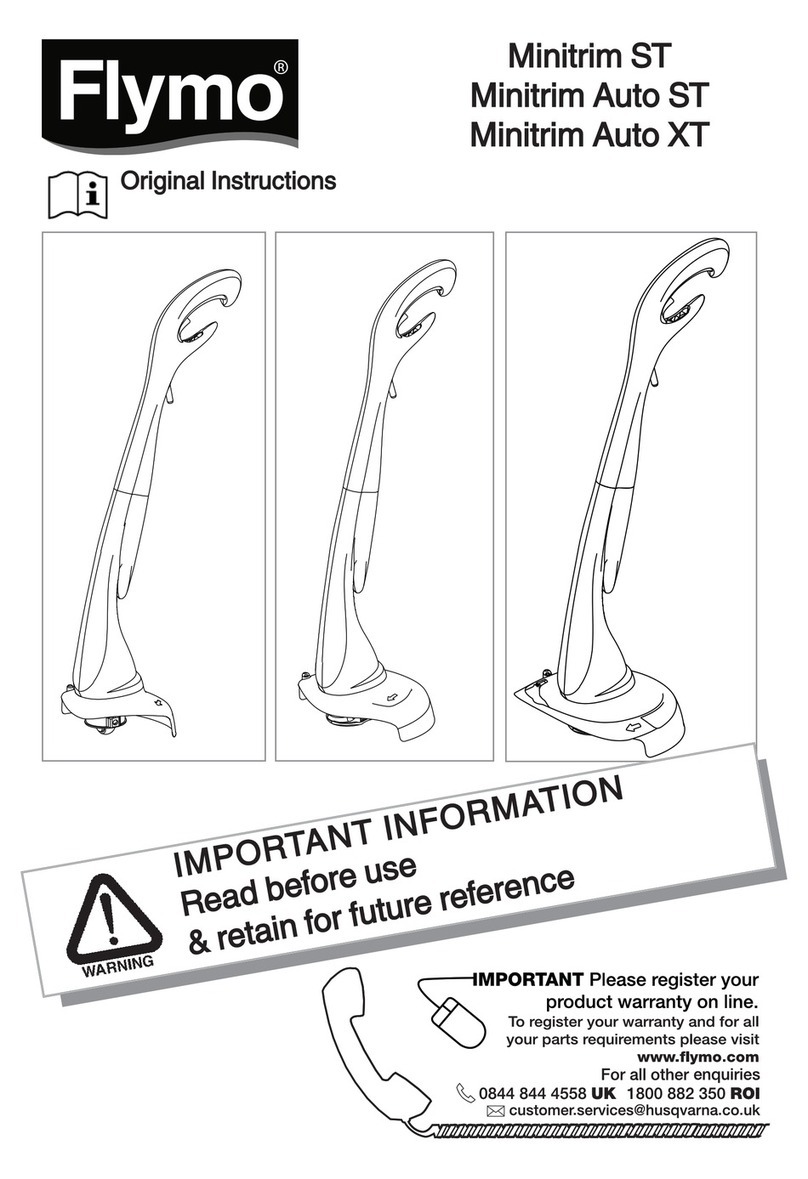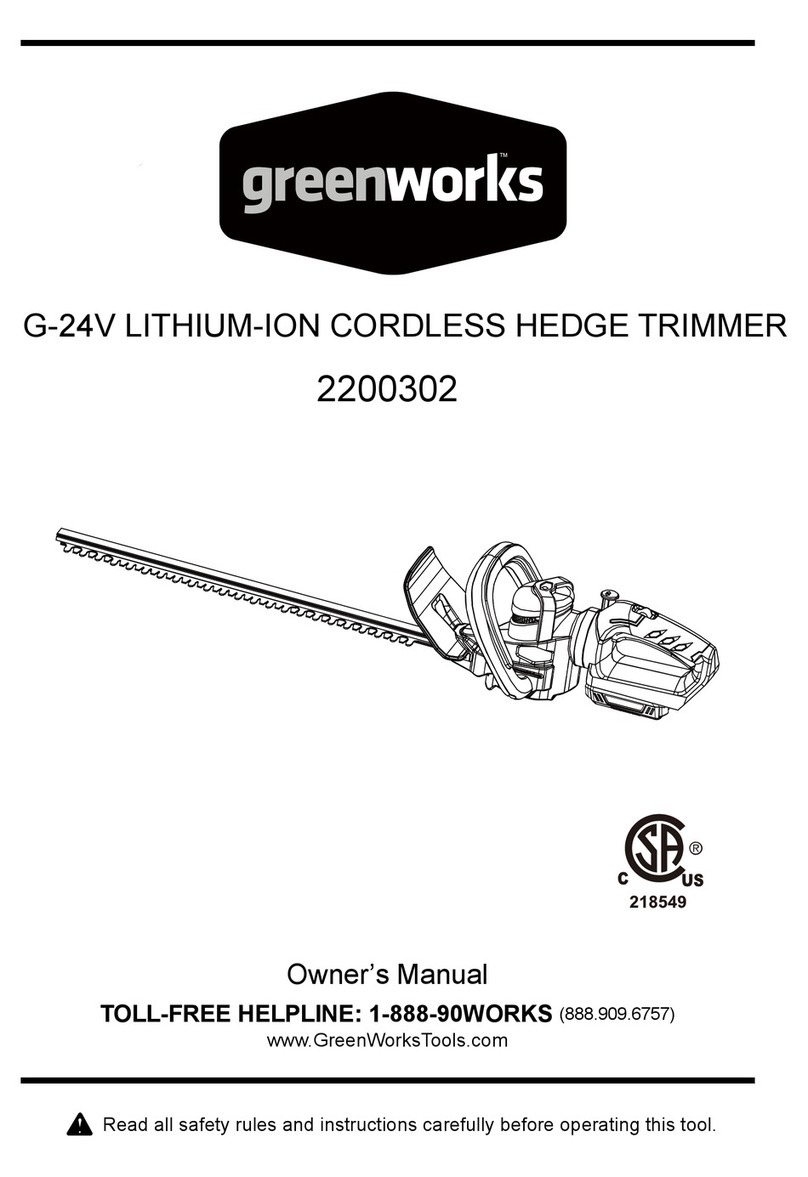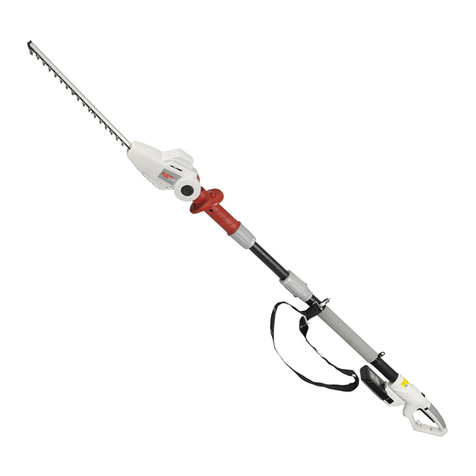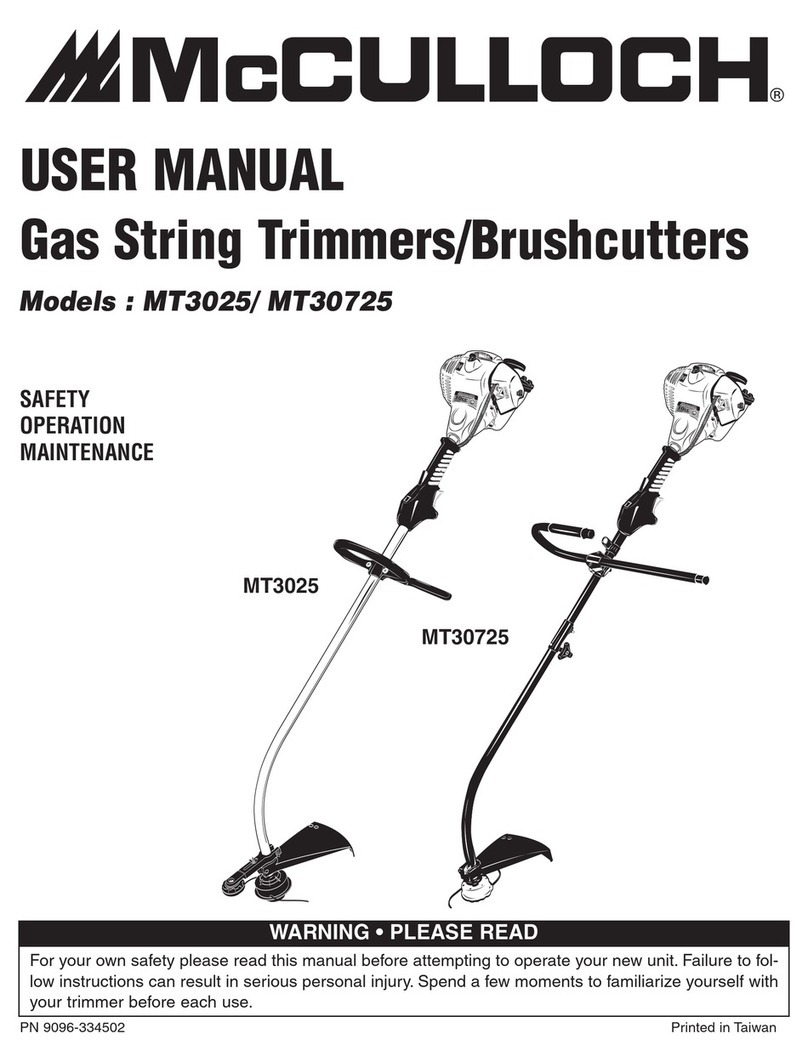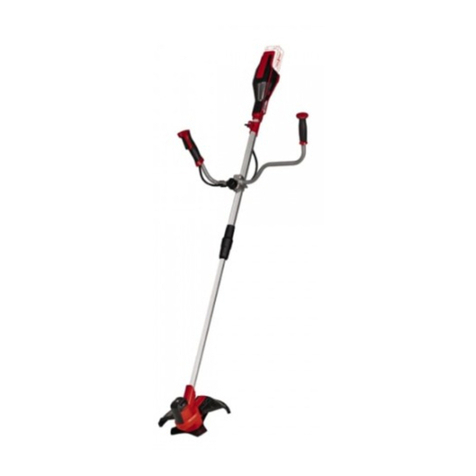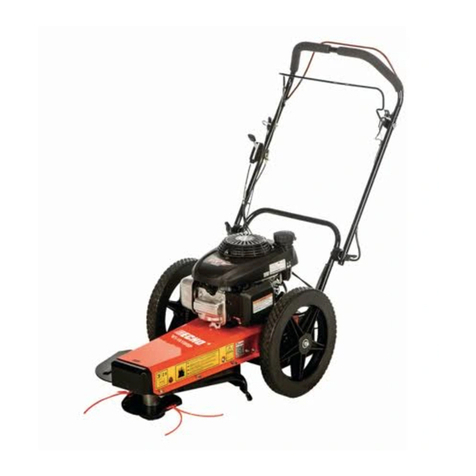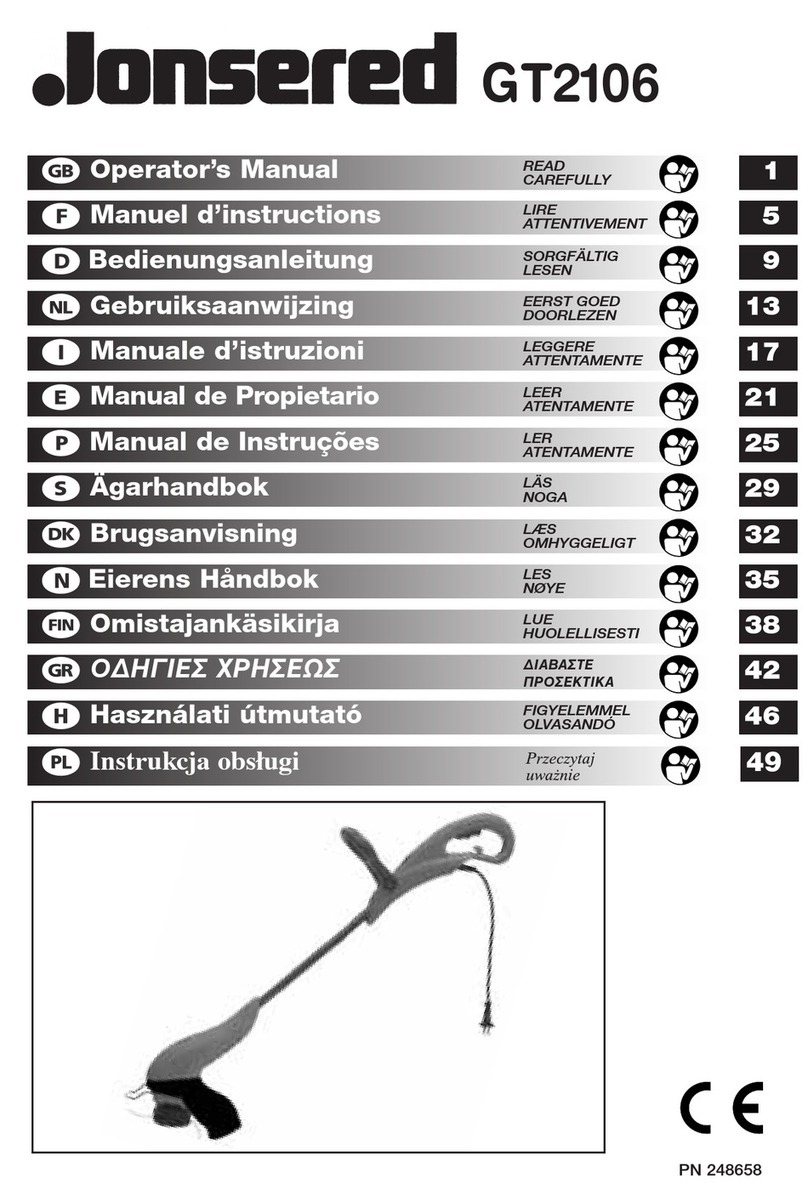HIKOKI M3608DA User manual

Handling instructions
使用說明書
en
zh
M3608DA
en
zh
ko
vi
th
id
ar
00BookM3608DATaiwan.indb100BookM3608DATaiwan.indb1 2021/07/2916:25:252021/07/2916:25:25

2
1
2
3 4
00BookM3608DATaiwan.indb200BookM3608DATaiwan.indb2 2021/07/2916:25:262021/07/2916:25:26

3
5
6
A
A
78
00BookM3608DATaiwan.indb300BookM3608DATaiwan.indb3 2021/07/2916:25:272021/07/2916:25:27

4
9
(6 mm) (8 mm)
10
40
30
40
11 12
a
13 14
00BookM3608DATaiwan.indb400BookM3608DATaiwan.indb4 2021/07/2916:25:282021/07/2916:25:28

5
15 16
B
17 18
19 20
ab
00BookM3608DATaiwan.indb500BookM3608DATaiwan.indb5 2021/07/2916:25:292021/07/2916:25:29

6
21
10
sec.
10
sec.
10
sec.
00BookM3608DATaiwan.indb600BookM3608DATaiwan.indb6 2021/07/2916:25:312021/07/2916:25:31

7
22 23
24 25
26
00BookM3608DATaiwan.indb700BookM3608DATaiwan.indb7 2021/07/2916:25:312021/07/2916:25:31

8
English
c) Prevent unintentional starting. Ensure the
switch is in the off-position before connecting
to power source and/or battery pack, picking up
or carrying the tool.
Carrying power tools with your finger on the switch
or energising power tools that have the switch on
invites accidents.
d) Remove any adjusting key or wrench before
turning the power tool on.
A wrench or a key left attached to a rotating part of
the power tool may result in personal injury.
e) Do not overreach. Keep proper footing and
balance at all times.
This enables better control of the power tool in
unexpected situations.
f) Dress properly. Do not wear loose clothing or
jewellery. Keep your hair and clothing away
from moving parts.
Loose clothes, jewellery or long hair can be caught in
moving parts.
g) If devices are provided for the connection of
dust extraction and collection facilities, ensure
these are connected and properly used.
Use of dust collection can reduce dust-related
hazards.
h) Do not let familiarity gained from frequent use
of tools allow you to become complacent and
ignore tool safety principles.
A careless action can cause severe injury within a
fraction of a second.
4) Power tool use and care
a) Do not force the power tool. Use the correct
power tool for your application.
The correct power tool will do the job better and safer
at the rate for which it was designed.
b) Do not use the power tool if the switch does not
turn it on and off.
Any power tool that cannot be controlled with the
switch is dangerous and must be repaired.
c) Disconnect the plug from the power source and/
or remove the battery pack, if detachable, from
the power tool before making any adjustments,
changing accessories, or storing power tools.
Such preventive safety measures reduce the risk of
starting the power tool accidentally.
d) Store idle power tools out of the reach of
children and do not allow persons unfamiliar
with the power tool or these instructions to
operate the power tool.
Power tools are dangerous in the hands of untrained
users.
e) Maintain power tools and accessories. Check
for misalignment or binding of moving parts,
breakage of parts and any other condition
that may affect the power toolʼs operation. If
damaged, have the power tool repaired before
use.
Many accidents are caused by poorly maintained
power tools.
f) Keep cutting tools sharp and clean.
Properly maintained cutting tools with sharp cutting
edges are less likely to bind and are easier to control.
g) Use the power tool, accessories and tool bits
etc. in accordance with these instructions,
taking into account the working conditions and
the work to be performed.
Use of the power tool for operations different from
those intended could result in a hazardous situation.
h) Keep handles and grasping surfaces dry, clean
and free from oil and grease.
Slippery handles and grasping surfaces do not
allow for safe handling and control of the tool in
unexpected situations.
GENERAL POWER TOOL SAFETY
WARNINGS
WARNING
Read all safety warnings, instructions, illustrations and
specifications provided with this power tool.
Failure to follow all instructions listed below may result in
electric shock, fire and/or serious injury.
Save all warnings and instructions for future reference.
The term “power tool” in the warnings refers to your mains-
operated (corded) power tool or battery-operated (cordless)
power tool.
1) Work area safety
a) Keep work area clean and well lit.
Cluttered or dark areas invite accidents.
b) Do not operate power tools in explosive
atmospheres, such as in the presence of
flammable liquids, gases or dust.
Power tools create sparks which may ignite the dust
or fumes.
c) Keep children and bystanders away while
operating a power tool.
Distractions can cause you to lose control.
2) Electrical safety
a) Power tool plugs must match the outlet. Never
modify the plug in any way. Do not use any
adapter plugs with earthed (grounded) power
tools.
Unmodified plugs and matching outlets will reduce
risk of electric shock.
b) Avoid body contact with earthed or grounded
surfaces, such as pipes, radiators, ranges and
refrigerators.
There is an increased risk of electric shock if your
body is earthed or grounded.
c) Do not expose power tools to rain or wet
conditions.
Water entering a power tool will increase the risk of
electric shock.
d) Do not abuse the cord. Never use the cord for
carrying, pulling or unplugging the power tool.
Keep cord away from heat, oil, sharp edges or
moving parts.
Damaged or entangled cords increase the risk of
electric shock.
e) When operating a power tool outdoors, use an
extension cord suitable for outdoor use.
Use of a cord suitable for outdoor use reduces the
risk of electric shock.
f) If operating a power tool in a damp location
is unavoidable, use a residual current device
(RCD) protected supply.
Use of an RCD reduces the risk of electric shock.
3) Personal safety
a) Stay alert, watch what you are doing and use
common sense when operating a power tool.
Do not use a power tool while you are tired
or under the influence of drugs, alcohol or
medication.
A moment of inattention while operating power tools
may result in serious personal injury.
b) Use personal protective equipment. Always
wear eye protection.
Protective equipment such as a dust mask, non-skid
safety shoes, hard hat or hearing protection used for
appropriate conditions will reduce personal injuries.
00BookM3608DATaiwan.indb800BookM3608DATaiwan.indb8 2021/07/2916:25:322021/07/2916:25:32

9
English
5) Battery tool use and care
a) Recharge only with the charger specified by the
manufacturer.
A charger that is suitable for one type of battery pack
may create a risk of fire when used with another
battery pack.
b) Use power tools only with specifically
designated battery packs.
Use of any other battery packs may create a risk of
injury and fire.
c) When battery pack is not in use, keep it away
from other metal objects, like paper clips, coins,
keys, nails, screws or other small metal objects,
that can make a connection from one terminal to
another.
Shorting the battery terminals together may cause
burns or a fire.
d) Under abusive conditions, liquid may be ejected
from the battery; avoid contact. If contact
accidentally occurs, flush with water. If liquid
contacts eyes, additionally seek medical help.
Liquid ejected from the battery may cause irritation or
burns.
e) Do not use a battery pack or tool that is damaged
or modified.
Damaged or modified batteries may exhibit
unpredictable behaviour resulting in fire, explosion
or risk of injury.
f) Do not expose a battery pack or tool to fire or
excessive temperature.
Exposure to fire or temperature above 130°C may
cause explosion.
g) Follow all charging instructions and do not
charge the battery pack or tool outside the
temperature range specified in the instructions.
Charging improperly or at temperatures outside
the specified range may damage the battery and
increase the risk of fire.
6) Service
a) Have your power tool serviced by a qualified
repair person using only identical replacement
parts.
This will ensure that the safety of the power tool is
maintained.
b) Never service damaged battery packs.
Service of battery packs should only be performed
by the manufacturer or authorized service providers.
PRECAUTION
Keep children and infirm persons away.
When not in use, tools should be stored out of reach of
children and infirm persons.
CORDLESS TRIMMER SAFETY
WARNINGS
1. Hold the power tool by insulated gripping surfaces,
when performing an operation where the cutting
accessory may contact hidden wiring.
Cutting accessory contacting a "live" wire may make
exposed metal parts of the power tool "live" and could
give the operator an electric shock.
2. Use clamps or another practical way to secure and
support the workpiece to a stable platform.
Holding the work by your hand or against the body
leaves it unstable and may lead to loss of control.
3. The bit and shaft, collet nut, collet cone are very hot
immediately after operation. Avoid bare hand contact
with the bit for any reason.
4. Use bits of the correct shank diameter suitable for the
speed of the tool.
ADDITIONAL SAFETY WARNINGS
1. Always charge the battery at a temperature of 0°C–40°C.
A temperature of less than 0°C will result in over charging
which is dangerous. The battery cannot be charged at a
temperature higher than 40°C.
The most suitable temperature for charging is that of
20°C–25°C.
2. Do not use the charger continuously.
When one charging is completed, leave the charger for
about 15 minutes before the next charging of battery.
3. Do not allow foreign matter to enter the hole for
connecting the rechargeable battery.
4. Never disassemble the rechargeable battery and
charger.
5. Never short-circuit the rechargeable battery.
Shortcircuiting the battery will cause a great electric
current and overheat. It results in burn or damage to the
battery.
6. Do not dispose of the battery in fire. If the battery is burnt,
it may explode.
7. Bring the battery to the shop from which it was purchased
as soon as the post-charging battery life becomes too
short for practical use. Do not dispose of the exhausted
battery.
8. Do not insert object into the air ventilation slots of the
charger. Inserting metal objects or inflammables into the
charger air ventilation slots will result in electrical shock
hazard or damaged charger.
9. When using this unit continuously, the unit may overheat,
leading to damage in the motor and switch. Therefore,
whenever the housing becomes hot, give the tool a
break for a while.
10. If the machine is used continuously at low speed, an
extra load is applied to the motor which can result in
motor seizure. Always operate the power tool so that the
bit is not caught by the material during operation. Always
adjust the bit speed to enable smooth cutting.
11. Preparing and checking the work environment. Make
sure that the work site meets all the conditions laid forth
in the precautions.
12. Make sure that the battery is installed firmly. If it is at all
loose it could come offand cause an accident.
13. Dust produced in operation
The dust produced in normal operation may affect
the operator’s health. Either of following way is
recommended.
a) Wear a dust mask
b) Use external dust collection equipment
(optional accessories) (Fig. 22)
When using the external dust collection equipment,
connect the adapter with the hose from external dust
collection equipment.
14. Handle the bits very carefully.
15. Check the bit carefully for cracks or damage before
operation. Replace cracked or damaged bit immediately.
16. Avoid cutting nails. Inspect for and remove all nails from
the workpiece before operation.
17. Make sure to securely hold the tool during operation.
Failure to do so can result in accidents or injuries.
(Fig. 24)
18. Make sure the bit is not contacting the workpiece before
the switch is turned on.
19. Before using the tool on an actual workpiece, let it run
for a while. Watch for vibration or wobbling that could
indicate improperly installed bit.
20. Be careful of the bit rotating direction and the feed
direction.
00BookM3608DATaiwan.indb900BookM3608DATaiwan.indb9 2021/07/2916:25:322021/07/2916:25:32

10
English
21. Always switch offand wait for the bit to come to a
complete stop before removing the tool from workpiece.
22. After changing the bits or making any adjustments, make
sure the collet nut and any other adjustment device are
securely tightened.
Loose adjustment device can unexpectedly shift,
causing loss of control, loose rotating components will
be violently thrown.
23. Do not expose directly your eye to the light by looking
into the light.
If your eye is continuously exposed to the light, your eye
will be hurt.
24. Never touch moving parts.
Never place your hands, fingers or other body parts near
the tool’s moving parts.
25. NEVER leave tool running unattended. Turn power off.
Don’t leave tool until it comes to a complete stop.
26. The power tool is equipped with a temperature
protection circuit to protect the motor. Continuous work
may cause the temperature of the unit to rise, activating
the temperature protection circuit and automatically
stopping operation. If this happens, allow the power tool
to cool before resuming use.
27. Do not give a strong shock to the switch panel or break it.
It may lead to a trouble.
28. Do not use the product if the tool or the battery terminals
(battery mount) are deformed.
Installing the battery could cause a short circuit that
could result in smoke emission or ignition.
29. Keep the tool’s terminals (battery mount) free of swarf
and dust.
○Prior to use, make sure that swarf and dust have not
collected in the area of the terminals.
○During use, try to avoid swarf or dust on the tool from
falling on the battery.
○When suspending operation or after use, do not leave
the tool in an area where it may be exposed to falling
swarf or dust.
Doing so could cause a short circuit that could result in
smoke emission or ignition.
30. Always use the tool and battery at temperatures between
-5°C and 40°C.
31. When operating the tool, do not wear work gloves as
such cloth wear can get caught in the tool.
CAUTION ON LITHIUM-ION BATTERY
To extend the lifetime, the lithium-ion battery equips with the
protection function to stop the output.
In the cases of 1 to 3 described below, when using this
product, even if you are pulling the switch, the motor may
stop. This is not the trouble but the result of protection
function.
1. When the battery power remaining runs out, the motor
stops.
In such a case, charge it up immediately.
2. If the tool is overloaded, the motor may stop. In this
case, release the switch of tool and eliminate causes of
overloading. After that, you can use it again.
3. If the battery is overheated under overload work, the
battery power may stop.
In this case, stop using the battery and let the battery
cool. After that, you can use it again.
Furthermore, please heed the following warning and caution.
WARNING
In order to prevent any battery leakage, heat generation,
smoke emission, explosion and ignition beforehand, please
be sure to heed the following precautions.
1. Make sure that swarf and dust do not collect on the
battery.
○During work make sure that swarf and dust do not fall on
the battery.
○Make sure that any swarf and dust falling on the power
tool during work do not collect on the battery.
○Do not store an unused battery in a location exposed to
swarf and dust.
○Before storing a battery, remove any swarf and dust that
may adhere to it and do not store it together with metal
parts (screws, nails, etc.).
2. Do not pierce battery with a sharp object such as a
nail, strike with a hammer, step on, throw or subject the
battery to severe physical shock.
3. Do not use an apparently damaged or deformed battery.
4. Do not use the battery in reverse polarity.
5. Do not connect directly to an electrical outlets or car
cigarette lighter sockets.
6. Do not use the battery for a purpose other than those
specified.
7. If the battery charging fails to complete even when a
specified recharging time has elapsed, immediately stop
further recharging.
8. Do not put or subject the battery to high temperatures or
high pressure such as into a microwave oven, dryer, or
high pressure container.
9. Keep away from fire immediately when leakage or foul
odor are detected.
10. Do not use in a location where strong static electricity
generates.
11. If there is battery leakage, foul odor, heat generated,
discolored or deformed, or in any way appears abnormal
during use, recharging or storage, immediately remove it
from the equipment or battery charger, and stop use.
12. Do not immerse the battery or allow any fluids to flow
inside. Conductive liquid ingress, such as water, can
cause damage resulting in fire or explosion. Store your
battery in a cool, dry place, away from combustible and
flammable items. Corrosive gas atmospheres must be
avoided.
CAUTION
1. If liquid leaking from the battery gets into your eyes,
do not rub your eyes and wash them well with fresh
clean water such as tap water and contact a doctor
immediately.
If left untreated, the liquid may cause eye-problems.
2. If liquid leaks onto your skin or clothes, wash well with
clean water such as tap water immediately.
There is a possibility that this can cause skin irritation.
3. If you find rust, foul odor, overheating, discolor,
deformation, and/or other irregularities when using the
battery for the first time, do not use and return it to your
supplier or vendor.
WARNING
If a conductive foreign matter enters in the terminal of lithium
ion battery, the battery may be shorted, causing fire. When
storing the lithium ion battery, obey surely the rules of
following contents.
○Do not place conductive debris, nail and wires such as
iron wire and copper wire in the storage case.
○To prevent shorting from occurring, load the battery in
the tool or insert securely the battery cover for storing
until the ventilator is not seen.
00BookM3608DATaiwan.indb1000BookM3608DATaiwan.indb10 2021/07/2916:25:322021/07/2916:25:32

11
English
REGARDING LITHIUM-ION BATTERY
TRANSPORTATION
When transporting a lithium-ion battery, please observe the
following precautions.
WARNING
Notify the transporting company that a package contains a
lithium-ion battery, inform the company of its power output
and follow the instructions of the transportation company
when arranging transport.
○Lithium-ion batteries that exceed a power output of
100 Wh are considered to be in the freight classification
of Dangerous Goods and will require special application
procedures.
○For transportation abroad, you must comply with
international law and the rules and regulations of the
destination country.
○If the BSL36B18 is installed in the power tool, the power
output will exceed 100 Wh and the unit will be classified
as Dangerous Goods for freight classification.
Wh
Power Output
2 to 3 digit number
NAMES OF PARTS (Fig. 1–Fig. 26)
Battery LED light
Head cover Switch Panel
Name plate Power button
Dial Power indicator lamp
Motor Latch
Rack portion Charge indicator lamp
Lock lever Removing
Pinion Fixing
Collet nut Socket wrench
(8 mm)
Collet cone Loosen
Base ass’y Tighten
Shaft 23 mm Wrench
Switch button Bit
Knob bolt (A) Collet cone hole
Fixing nut 13 mm Wrench
Lock pin Upper end of base
ass’y
Knob bolt (B) Scale
Template guide Center hole
Screw Nail (rotation axis)
Template Dust collector
Trimmer guide Positioning hole
Guide pin Protrusion
Stop screw Screw hole
Knob bolt (C) Knob bolt (D)
Washer (A) Work piece
Body feed direction Rotation of bit
Straight guide Trimmer feed
Guide holder
Inner peripheral
cutting
(Clockwise)
Wing nut
Outer peripheral
cutting
(Counterclockwise)
Bolt Air gun
Wave washer Battery sliding
grooves
Washer Ventilation holes
SYMBOLS
WARNING
The following show symbols used for the machine.
Be sure that you understand their meaning before
use.
M3608DA: Cordless Trimmer
To reduce the risk of injury, user must read
instruction manual.
Always wear eye protection.
Always wear hearing protection.
Direct current
V Rated voltage
n0No-load speed
Disconnect the battery
Switching ON
Switching OFF
Warning
Prohibited action
00BookM3608DATaiwan.indb1100BookM3608DATaiwan.indb11 2021/07/2916:25:322021/07/2916:25:32

12
English
Battery
Lights ;
The battery remaining power is over 75%
Lights ;
The battery remaining power is 50%–75%.
Lights ;
The battery remaining power is 25%–50%.
Lights ;
The battery remaining power is less than 25%
Blinks ;
The battery remaining power is nearly empty.
Recharge the battery soonest possible.
Blinks ;
Output suspended due to high temperature.
Remove the battery from the tool and allow it to
fully cool down.
Blinks ;
Output suspended due to failure or malfunction.
The problem may be the battery so please
contact your dealer.
STANDARD ACCESSORIES
In addition to the main unit (1 unit), the package contains the
accessories listed on page 29.
Standard accessories are subject to change without notice.
APPLICATIONS
○Woodworking jobs centered on grooving and
chamfering.
SPECIFICATIONS
1. Power tool
Model M3608DA
Voltage 36 V
No-Load Speed 10000–30000 /min
Collet cone capacity 8 mm, 6 mm or 1/4"
Main Body Stroke 40 mm
Weight 1.9 kg (BSL36A18)
2.2 kg (BSL36B18)
* Existing batteries (BSL3660/3620/3626, BSL18xx
series, etc.) cannot be used with this tool.
NOTE
Due to HiKOKI’s continuing program of research and
development, the specifications herein are subject to
change without prior notice.
2. Battery
Model BSL36A18 BSL36B18
Voltage 36 V / 18 V (Automatic Switching*)
Battery capacity 2.5 Ah / 5.0 Ah 4.0 Ah / 8.0 Ah
(Automatic Switching*)
Available cordless
products** Multi volt series, 18 V product
Available charger Sliding charger for lithium ion
batteries
* The tool itself will automatically switch over.
** Please see our general catalogue for details.
CHARGING
Before using the power tool, charge the battery as follows.
1. Connect the charger’s power cord to the receptacle.
When connecting the plug of the charger to a receptacle,
the charge indicator lamp will blink in red (At 1- second
intervals).
2. Insert the battery into the charger.
Firmly insert the battery into the charger as shown in
Fig. 3 (on page 2).
3. Charging
When inserting a battery in the charger, the charge
indicator lamp will blink in blue.
When the battery becomes fully recharged, the charge
indicator lamp will light up in green. (See Table 1)
(1) Charge indicator lamp indication
The indications of the charge indicator lamp will be as
shown in Table 1, according to the condition of the
charger or the rechargeable battery.
00BookM3608DATaiwan.indb1200BookM3608DATaiwan.indb12 2021/07/2916:25:342021/07/2916:25:34

13
English
Table 1
Indications of the charge indicator lamp
Charge
indicator
lamp
(RED /
BLUE /
GREEN /
PURPLE)
Before
charging
Blinks
(RED)
Lights for 0.5 seconds. Does not light for
0.5 seconds. (offfor 0.5 seconds) Plugged into power source
While
charging
Blinks
(BLUE)
Lights for 0.5 seconds. Does not light for
1 second. (offfor 1 second) Battery capacity at less than 50%
Blinks
(BLUE)
Lights for 1 second. Does not light
for 0.5 seconds. (offfor 0.5 seconds) Battery capacity at less than 80%
Lights
(BLUE)
Lights continuously Battery capacity at more than 80%
Charging
complete
Lights
(GREEN)
Lights continuously
(Continuous buzzer sound: about
6 seconds)
Overheat
standby
Blinks
(RED)
Lights for 0.3 seconds. Does not light for
0.3 seconds. (offfor 0.3 seconds)
Battery overheated. Unable to
charge. (Charging will commence
when battery cools)
Charging
impossible
Flickers
(PURPLE)
Lights for 0.1 seconds. Does not light for
0.1 seconds. (offfor 0.1 seconds)
(Intermittent buzzer sound: about
2 seconds)
Malfunction in the battery or the
charger
(2) Regarding the temperatures and charging time of the rechargeable battery
The temperatures and charging time will become as shown in Table 2.
Table 2
Charger UC18YSL3
Battery
Type of battery Li-ion
Temperatures at which the
battery can be recharged 0°C–50°C
Charging voltage V 14.4 18
Charging time,
approx. (At 20°C)
BSL14xx series BSL18xx series Multi volt
series
(4 cells) (8 cells) (5 cells) (10 cells) (10 cells)
min
BSL1415S : 15
BSL1415 : 15
BSL1415X : 15
BSL1420 : 20
BSL1425 : 25
BSL1430C : 30
BSL1430 : 20
BSL1440 : 26
BSL1450 : 32
BSL1460 : 38
BSL1815S : 15
BSL1815 : 15
BSL1815X : 15
BSL1820 : 20
BSL1825 : 25
BSL1830C : 30
BSL1850C : 32
BSL1830 : 20
BSL1840 : 26
BSL1850 : 32
BSL1860 : 38
BSL36A18 : 32
BSL36B18 : 52
NOTE
The recharging time may vary according to the ambient temperature and power source voltage.
4. Disconnect the charger’s power cord from the
receptacle.
5. Hold the charger firmly and pull out the battery.
NOTE
Be sure to pull out the battery from the charger after use,
and then keep it.
Regarding electric discharge in case of new batteries,
etc.
As the internal chemical substance of new batteries and
batteries that have not been used for an extended period
is not activated, the electric discharge might be low when
using them the first and second time. This is a temporary
phenomenon, and normal time required for recharging
will be restored by recharging the batteries 2–3 times.
00BookM3608DATaiwan.indb1300BookM3608DATaiwan.indb13 2021/07/2916:25:342021/07/2916:25:34

14
English
How to make the batteries perform longer.
(1) Recharge the batteries before they become completely
exhausted.
When you feel that the power of the tool becomes
weaker, stop using the tool and recharge its battery. If
you continue to use the tool and exhaust the electric
current, the battery may be damaged and its life will
become shorter.
(2) Avoid recharging at high temperatures.
A rechargeable battery will be hot immediately after
use. If such a battery is recharged immediately after
use, its internal chemical substance will deteriorate, and
the battery life will be shortened. Leave the battery and
recharge it after it has cooled for a while.
CAUTION
○If the battery is charged while it is heated because
it has been left for a long time in a location subject to
direct sunlight or because the battery has just been
used, the charge indicator lamp of the charger lights
for 0.3 seconds, does not light for 0.3 seconds (offfor
0.3 seconds). In such a case, first let the battery cool,
then start charging.
○When the charge indicator lamp flickers (at 0.2-second
intervals), check for and take out any foreign objects in
the charger’s battery connector. If there are no foreign
objects, it is probable that the battery or charger is
malfunctioning. Take it to your authorized Service
Center.
○Since the built-in micro computer takes about
3 seconds to confirm that the battery being charged with
UC18YSL3 is taken out, wait for a minimum of 3 seconds
before reinserting it to continue charging. If the battery
is reinserted within 3 seconds, the battery may not be
properly charged.
PRIOR TO OPERATION
WARNING
Pull out battery before carrying out any adjustment,
servicing or maintenance.
When finished with a job, pull out the battery.
1. Removing and inserting the battery (Fig. 2)
2. Remaining battery indicator (Fig. 4)
3. Installation direction of base ass’y (Fig. 5)
The switch position can be changed according to
preference by reversing the installation direction of the
base ass’y.
4. Fix strength adjustment method (Fig. 6)
If there is a decline in the fix strength, adjust as follows.
Tilt the lock lever towards the fixed side, and tighten
a fixing nut (two locations) using the socket wrench
(8 mm).
Fix it so that upper and lower spaces “A” of the base
ass’y are equal.
NOTE
If the operation load of the lock lever is too heavy, there
is too much fixed strength.
As this situation may damage parts, each fixing nut
(two locations) should be loosened to readjust the fixed
strength.
INSTALLING AND REMOVING BITS
WARNING
Be sure to switch power OFF and pull out the battery to
avoid serious trouble.
1. Installation using the lock pin (Fig. 7)
(1) Remove the base ass’y from the body.
(2) Deeply insert the bit into collet cone hole. (The distance
is 15 mm or more from side of collet nut.
(3) With the bit inserted and pressing the lock pin holding
the shaft, use the 23 mm wrench to firmly tighten the
collet nut in a clockwise direction (viewed from under the
tool). (Fig. 7)
(4) Fit the removed base ass'y to the rack provided on the
body's outer housing after adjusting the pinion of the
base ass'y thereto. Then tilt the lock lever towards the fix
side, and fix the base ass'y securely.
When removing the bits, do so by following the steps for
installing bits in reverse order.
CAUTION
○Ensure that the collet nut is firmly tightened after inserting
a bit. Failure to do so will result in damage to the collet
cone.
○Ensure that the lock pin is not inserted into the shaft after
tightening the collet nut. Failure to do so will result in
damage to the collet cone, lock pin and shaft.
2. Install without using the lock pin (Fig. 8)
(1) Remove the base ass’y from the body.
(2) Deeply insert the bit into collet cone hole. (The distance
is 15 mm or more from side of collet nut.
(3) Use a 13 mm wrench to secure the shaft, and securely
tighten the collet nut with the included wrench.
(4) Fit the removed base ass'y to the rack provided on the
body's outer housing after adjusting the pinion of the
base ass'y thereto. Then tilt the lock lever towards the fix
side, and fix the base ass'y securely.
When removing the bits, do so by following the steps for
installing bits in reverse order.
CAUTION
○Ensure that the collet nut is firmly tightened after inserting
a bit. Failure to do so will result in damage to the collet
cone.
3. Exchanging the collet cone (Fig. 9)
(1) Securing the shaft, remove the collet nut, and exchange
the collet cone.
(2) Attach the nut, insert the bit, and tighten the nut.
NOTE
When tightening the collet nut, make sure that the bit is
inserted.
Otherwise, the collet cone may become misshapen.
HOW TO USE THE TRIMMER
1. Adjusting depth of cut (Fig. 10)
(1) Place the tool on a flat wood surface.
(2) Tilt the lock lever towards the remove side, and turn
knob bolt (A) to lower the unit until the tip of the bit lightly
touches the material. In this position, the scale on the
upper end of the base ass'y can be read.
(3) Turn knob bolt (A) upwards to adjust the scale to the
desired cutting depth according in accordance with the
position read.
00BookM3608DATaiwan.indb1400BookM3608DATaiwan.indb14 2021/07/2916:25:342021/07/2916:25:34

15
English
2. Guiding the trimmer
WARNING
Be sure to switch power OFF and pull out the battery to
avoid serious trouble.
(1) Template Guide (Standard accessory)
It is handy to process with a template a number of
materials in one same shape.
(In this case 6 × 6 mm or 1/4" × 1/4" straight bit is usable.)
Remove the base ass'y from the main unit.
Install the template guide in the recessed part of the
base ass'y and secure it with two screws. (Fig. 11)
NOTE
Tighten the two screws moderately. Optimum tightening
torque is 10–15 kg-cm.
Install the base ass'y in the main unit.
CAUTION
When fit the template guide, the upper part of the
template guide must not touch the collet nut.
When using the trimmer along the interior plane of the
template, the dimensions of the finished product will be
less than the dimensions of the template by a amount
equal to dimension “a”, the difference between the
radius of the template guide and the radius of the bit. The
reverse is true when using the trimmer along the exterior
of the template. (Fig. 12)
Secure the template to the workpiece. Feed the trimmer
in the manner that the template guide moves along the
template as shown in Fig. 13.
(2) Trimmer guide (Standard accessory)
The guide is handy when used in processing of materials
such as trimming and beveling of plywood.
Fit the trimmer guide on the base ass’y with knob bolt
(B).
Loosen knob bolt (B) to move the trimmer guide up and
down.
Loosen knob bolt (C) and turn the stop screw to move
the guide pin. (Fig. 14)
After moving the guide pin, tighten knob bolt (C) to
secure it.
As shown in Fig. 15, securely attach the bottom of the
base ass’y to processed surface of the materials. Feed
the trimmer with the guide pin alongside the material.
(3) Straight guide (Standard accessory)
Application:
○It is handy when used for linear processing work such as
beveling, grooving and the like.
Fit the straight guide with knob bolt (B) on the base ass’y
and fix it.
Adjust the length "B" from the bit to the surface of straight
guide by loosening the wing nut and moving the straight
guide as necessary. (Fig. 16)
As shown in Fig. 17, securely attach the bottom of the
base ass’y to processed surface of the materials. Feed
the trimmer while keeping the guide plane on the surface
of the materials.
○By exchanging the straight guide with the guide holder,
the tool can be used for circle cutting work.
[Processing range (distance from the enter of rotation to
the center of the bit)]
Minimum: 84 mm
Maximum: 182 mm
Note that circles measuring 102 to 124 mm and 143 mm
to 158 mm cannot be processed.
Turn wing nut and remove the bolt and washers
(2 pieces).
Reverse the top and bottom of the straight guide and
attach it to the guide holder. (Fig. 18)
Depending on the radius of the circle to be processed,
the holes will vary for the wing nut and bolt.
Processing a circle with a radius of 84 to 102 mm
(Fig. 19-a)
Processing a circle with a radius of 124 to 182 mm
(Fig. 19-b)
Installation to the tool is the same as that for straight line
processing.
Align the hole of the straight guide left in the center
position of the circle processing, and firmly secure with
a nail less than 6 mm in diameter which will act as a
rotation axis.
Rotate the body towards the right. (Fig. 20)
3. Switch operation (Fig. 21)
The unit will operate when the switch button is pressed
after pressing the power button.
See Fig. 21 for specifications on button controls.
The power indicator lamp and LED light will always
operate together with the power button.
If the power is ON and the tool is not operated
for approximately 10 seconds, the power will be
automatically switched OFF and the power indicator
lamp and LED light will also be switched off.
4. Dust Collector Set (Standard accessory) (Fig. 22)
Connect the dust collector set cleaner to collect dust.
(1) Slot the protrusion on the inside of the dust collector to
the positioning hole at the front lower left of the base
ass’y, and attach it to cover the front of the base ass’y.
(2) Using the included knob bolt (D) to secure the dust
collector hole to the body’s screw hole.
5. Adjusting the rotation speed
The M3608DA has an electronic control system that
allows rotation speed changes.
As shown in Fig. 23, dial position “1” is for minimum
speed, and position “6” for maximum speed.
6. Cutting
CAUTION
○Wear eye protection when operating this tool.
○Keep your hands, face and other body parts away from
the bits and any other rotating parts, while operating the
tool.
NOTE
○Do not press the lock pin while the motor is rotating.
Also, do not switch the tool on while pressing the lock
pin.
Doing so may damage the lock pin and/or shaft as well
as result in injury.
○Please limit the cutting depth of a single cut to under
5 mm.
○When cutting a deep groove, repeat the cut 2 or 3 times.
Deep cutting operations can make the tool difficult
to control and may overload the motor, resulting in
malfunction.
○Moving the tool forward fast may cause a poor quality
of cut, or damage to the bit or motor. Moving the tool
forward too slowly may burn and mar the cut.
The proper feed rate will depend on the bit size, the kind
of workpiece and depth of cut. Before beginning the cut
on the actual workpiece, it is advisable to make a sample
cut on a piece of scrap lumber. This will show exactly
how the cut will look as well as enable you to check
dimensions.
○Abnormalities and overloads will trigger the overload
protector, and stop operation. Remove the load
immediately, and turn the power off, then on. The
rotation speed should return to normal.
It is recommended that the most appropriate guide be
used which is suitable to the type of the work in order to
carry out the work exactly without failure.
(Refer to "2. Guiding the trimmer".) The workpieces to be
processed should be firmly fixed.
00BookM3608DATaiwan.indb1500BookM3608DATaiwan.indb15 2021/07/2916:25:352021/07/2916:25:35

16
English
(1) Keep the bit separated from the workpieces and hold the
body firmly before switch is turned on. (Fig. 24)
(2) The bit rotates clockwise (arrow direction indicated
on the base ass’y). To obtain maximum cutting
effectiveness, feed the trimmer in conformance with the
feed directions shown in Fig. 25.
LED LIGHT WARNING SIGNALS
(Fig. 27)
This product features functions that are designed to protect
the tool itself as well as the battery. When any of the
safeguard functions are triggered, any of the LED light will
blink as described in Table 3.
In this case, follow the instructions described under
corrective action.
NOTE
On occasion, about two seconds after stopping
operation of the tool, the LED light will shut offand the
power will switch OFF.
This means that either the power is near empty or that
the battery is overheated.
In such a case, allow the battery to cool and then
recharge it for use.
Fig. 27
Table 3
Safeguard Function LED Light Display Corrective Action
Overload Protection On 0.1 second/off0.1 second Remove the cause of the overloading.
Temperature Protection On 0.5 second/off0.5 second Allow the tool and battery to thoroughly cool.
MAINTENANCE AND INSPECTION
WARNING
Be sure to turned offthe switch and remove the battery
before maintenance and inspection.
1. Inspecting the bit
Continued use of a dull or damaged bit will result in
reduced cutting efficiency and may cause overloading
of the motor. Replace the bit with a new one as soon as
excessive abrasion is noted.
2. Inspecting the mounting screws
Regularly inspect all mounting screws and ensure that
they are properly tightened. Should any of the screws be
loose, retighten them immediately. Failure to do so could
result in serious hazard.
3. Maintenance of the motor
The motor unit winding is the very “heart” of the power
tool.
Exercise due care to ensure the winding does not
become damaged and/or wet with oil or water.
4. Inspection of terminals (tool and battery)
Check to make sure that swarf and dust have not
collected on the terminals.
On occasion check prior, during and after operation.
CAUTION
Remove any swarf or dust which may have collected on
the terminals.
Failure to do so may result in malfunction.
5. Cleaning on the outside
WARNING
Wear protective glasses and a dust mask when cleaning
the filter with an air gun.
Failure to do so may result in inhalation or exposure of
the eyes to debris or dust.
Use an air gun or other similar tool to remove materials,
chips, etc. which have adhered to the body (especially
where indicated in Fig. 26), and wipe with a soft dry cloth
or a cloth moistened with soapy water. Do not use chloric
solvents, gasoline or paint thinner, for they melt plastics.
6. Storage
Store the power tool and battery in a place in which
the temperature is less than 40°C and out of reach of
children.
NOTE
Storing lithium-ion batteries.
Make sure the lithium-ion batteries have been fully
charged before storing them.
Prolonged storage (3 months or more) of batteries with
a low charge may result in performance deterioration,
significantly reducing battery usage time or rendering
the batteries incapable of holding a charge.
However, significantly reduced battery usage time may
be recovered by repeatedly charging and using the
batteries two to five times.
If the battery usage time is extremely short despite
repeated charging and use, consider the batteries dead
and purchase new batteries.
CAUTION
In the operation and maintenance of power tools, the
safety regulations and standards prescribed in each
country must be observed.
00BookM3608DATaiwan.indb1600BookM3608DATaiwan.indb16 2021/07/2916:25:352021/07/2916:25:35

17
English
SELECTING ACCESSORIES
The accessories of this machine are listed on page 30.
For details regarding each bit type, please contact the
HiKOKI Authorized Service Center.
Important notice on the batteries for the HiKOKI
cordless power tools
Please always use one of our designated genuine batteries.
We cannot guarantee the safety and performance of
our cordless power tool when used with batteries other
than these designated by us, or when the battery is
disassembled and modified (such as disassembly and
replacement of cells or other internal parts).
NOTE
Due to HiKOKI’s continuing program of research and
development, the specifications herein are subject to
change without prior notice.
TROUBLESHOOTING
WARNING
○To avoid injury from an accidental start, turn the switch OFF and remove the plug from the power source or remove the
battery from the main body before making any adjustments.
○All electrical or mechanical repairs should be done only by qualified service technicians. Contact HiKOKI Authorized
Service Center.
1. Power tool
Problem Possible Cause Remedy
Tool doesn’t run No remaining battery power Charge the battery.
Battery isn’t fully installed. Push the battery in until you hear a click.
The power is OFF.
Press the power button to switch the power ON.
Tool suddenly stopped Tool was overburdened
Get rid of the problem causing the overburden.
During operation, lighten the applied pressure.
Battery or tool overheated Allow the tool and battery to thoroughly cool.
No remaining battery power Charge the battery.
Doesn’t cut well The bit is worn or missing teeth. Replace with a new bit.
The collet chuck is loose. Firmly tighten the collet chuck.
Battery cannot be installed Attempting to install a battery other than that
specified for the tool.
Please install batteries that are multi volt or
BSL18xx series.
2. Charger
Symptom Possible cause Remedy
The charge indicator lamp
rapidly flickers purple, and
battery charging doesn’t
begin.
The battery is not inserted all the way. Insert the battery firmly.
There is foreign matter in the battery
terminal or where the battery is attached.
Remove the foreign matter.
The charge indicator lamp
blinks red, and battery
charging doesn’t begin.
The battery is not inserted all the way. Insert the battery firmly.
The battery is overheated. If left alone, the battery will automatically
begin charging if its temperature decreases,
but this may reduce battery life. It is
recommended that the battery be cooled in
a well-ventilated location away from direct
sunlight before charging it.
Battery usage time is short
even though the battery is
fully charged.
The battery’s life is depleted. Replace the battery with a new one.
The battery takes a long
time to charge.
The temperature of the battery, the charger,
or the surrounding environment is extremely
low.
Charge the battery indoors or in another
warmer environment.
The charger’s vents are blocked, causing its
internal components to overheat.
Avoid blocking the vents.
The cooling fan is not running. Contact a HiKOKI Authorized Service
Center for repairs.
00BookM3608DATaiwan.indb1700BookM3608DATaiwan.indb17 2021/07/2916:25:352021/07/2916:25:35

18
中國語
c) 防止意外啟動。在連接電源及或電池組、拿
起或攜帶工具前,請確認開關是在「off」(關閉)
的位置。
以手指放在開關握持電動工具,或在電動工具
的開關於“on”的狀況下插上插頭,都會導致
意外發生。
d) 在將電動工具啟動前,先卸下任何調整用鑰匙
或扳手。
扳手或鑰匙遺留在電動工具的轉動部位時,可
能導致人員傷害。
e)
身體勿過度伸張,任何時間要保持站穩及平衡。
以便在不預期的狀態下,能對電動工具有較好
的控制。
f) 衣著要合宜,別穿太鬆的衣服或戴首飾。
保持您的頭髮、衣服遠離轉動部位。
寬鬆的衣服、手飾及長髮會被捲入轉動部位。
g) 如果裝置要用於粉塵抽取及集塵設施,要確保
其連接及正當使用。
使用集塵裝置可減少與灰塵相關的危險。
h) 請勿因頻繁使用本工具,熟悉操作而忽略本工
具的安全原則。
粗心的行動有可能瞬間即造成嚴重傷害。
4) 電動工具之使用及注意事項
a) 勿強力使用電動工具,使用正確之電動工具為
你所需。
正確使用電動工具會依其設計條件使工作做得
更好更安全。
b) 如果開關不能轉至開及關的位置,勿使用電動
工具。
任何電動工具不能被開關所控制是危險的,必
須要修理。
c) 在進行任何調整、更換配件或收存電動工具之
前,請斷開插頭與電源的連接,且 / 或將電池
從電動工具中取出 ( 如果電池為可拆卸式 )。
此種預防安全措施可減少意外開啟電動機之危
險。
d) 收存停用之電動工具,遠離兒童,且不容許不
熟悉電動工具或未瞭解操作電動工具說明書的
人操作電動工具。
在未受過訓練的人手裡,電動工具極為危險。
e) 保養電動工具和配件。檢核是否有可動零件錯
誤的結合或卡住、零件破裂及可能影響電動工
具操作的任何其他情形。電動工具如果損壞,
在使用前要修好。
許多意外皆肇因於不良的保養。
f) 保持切割工具銳利清潔。
適當的保養切割工具,保持銳利之切削鋒口,
可減少卡住並容易控制。
g) 按照說明書使用電動工具、配件及刀具時,必
須考量工作條件及所執行之工作。
若未依照這些使用說明操作電動工具時,可能
造成相關之危害情況。
一般安全規則
警告
閱讀本電動工具提供的所有安全警告、指示、說明
和規範。
未遵守下列之說明可能導致觸電、火災及 / 或嚴重傷
害。
請妥善保存所有警告與說明,以供未來參考之用。
「電動工具」一詞在警告中,係指電源操作(有線)
之電動工具或電池操作(無線)之電動工具。
1) 工作場所安全
a) 保持工作場所清潔及明亮。
雜亂或昏暗的區域容易發生意外。
b) 勿在易產生爆炸之環境中操作,譬如有易燃液
體、瓦斯或粉塵存在之處。
電動工具產生火花會引燃粉塵或煙氣。
c)
當操作電動工具時,保持兒童及過往人員遠離。
分神會讓你失去控制。
2) 電氣安全
a) 電動工具插頭必須與插座配合,絕不可以任何
方法修改插頭,且不得使用任何轉接插頭於有
接地之電動工具。
不修改插頭及所結合之插座可減少電擊。
b) 避免身體接觸到接地面諸如管子、散熱器、爐
灶及冰箱。
如果你的身體接地或搭地,會增加電擊的危險。
c) 勿讓電動工具淋雨或曝露在潮濕的環境下。
電動工具進水會增加電繫的危險。
d) 勿濫用電源線。絕勿使用電源線去纏繞、拖拉
電動工具或拔插頭,保持電源線遠離熱氣、油
氣、尖角或可動零件。
損壞或纏繞的電源線會增加電繫之危險。
e) 電動工具在室外操作時要使用一適合室外用的
延長線。
使用合適之室外用延長線會減少電擊的危險。
f) 若無法避免在潮濕地區操作電動工具,請使用
以殘餘電流裝置 (RCD) 保護的電源。
使用 RCD 可降低觸電危險。
3) 人員安全
a) 保持機警,注意你正在做什麼,並運用普通常
識操作電動工具。
當你感到疲勞或受藥品、酒精或醫療影響時,
勿操作電動工具。
操作中瞬間的不注意可能造成人員嚴重的傷
害。
b) 使用個人防護裝備,經常配戴安全眼鏡。
配戴防塵口罩、防滑安全鞋、硬帽等防護裝備,
或在適當情況下使用聽覺防護,可減少人員傷
害。
00BookM3608DATaiwan.indb1800BookM3608DATaiwan.indb18 2021/07/2916:25:352021/07/2916:25:35

19
中國語
h) 保持把手和握持面乾燥、清潔,且未沾到油脂
和潤滑油。
滑溜的把手和握持面在操作時會有安全上的問
題,且可能造成本工具意外失去控制。
5) 電池式工具的使用及注意事項
a) 需再充電時,僅能使用製造商指定的充電器。
因充電器僅適合同一型式的電池組,若使用任
何其它電池組時,將導致起火的危險。
b) 使用電動工具時,僅能使用按照其特性設計的
電池組。
因使用其它任何電池組時,將導致人員傷害及
起火的危險。
c) 當電池組不在使用時,需保存遠離其它的金屬
物件,例如:迴紋針、錢幣、鑰匙、圖釘、螺
釘,或類似能造成端子與端子間連接的其它較
小金屬物件。
因電池組端子間短路時,將導致燃燒或起火的
危險。
d) 在誤用情況下,電解液可能自電池中噴出;請
避免接觸。當發生意外接觸時,請用清水沖
洗。若電解液觸及眼睛時,請儘速尋求醫療協
助。
因自電池中噴出的電解液,將導致灼傷或刺激
皮膚。
e) 請勿使用損壞或改造的電池組或工具。
損壞或改造的電池可能會發生不可預知的行
為,進而導致火災、爆炸或受傷的風險。
f) 請勿使電池組或工具接觸到火源或處於溫度過
高的地方。
接觸火源或溫度超過 130℃可能會引起爆炸。
g) 請遵循所有充電指示,並且不要在說明書指定
的溫度範圍之外為電池組或工具充電。
充電不當或溫度超出指定範圍可能會損壞電池
並增加火災的風險。
6) 維修
a) 讓你的電動工具由合格修理人員僅使用相同的
維修零件更換。
如此可確保電動工具的安全得以維持。
b) 切勿對損壞的電池組進行維修。
電池組的維修只能由製造商或授權服務商進
行。
注意事項
不可讓孩童和體弱人士靠近工作場所。
應將不使用的工具存放在孩童和體弱人士伸手不及
的地方。
充電式修剪機安全警告
1. 進行切割配件可能接觸到暗線的操作時,請握著
電動工具的絕緣手柄表面。
接觸到“通電”電線的切割配件可能使電動工具
的金屬零件“通電”,而造成操作人員觸電。
2. 使用夾具或其他可實施的方式將工件固定並支撐
在穩定的平台上。
用手握住工件或用身體抵住工件會使其不穩定,
並可能導致失去控制。
3. 在剛操作後,刀刃和軸、筒夾螺帽、筒夾錐會非
常熱。避免因任何原因徒手觸碰刀刃。
4. 使用適合工具速度的正確長柄直徑的鑽頭。
附加安全警告
1. 給電池充電時溫度必須為 0℃-40℃。溫度低於
0℃ 會導致過度充電,這是很危險的。不能在溫
度高於 40℃ 時給電池充電。
最合適的充電溫度是 20℃-25℃。
2. 請勿連續使用充電器。
完成一次充電後,將充電器放置約 15 分鐘後才
能再次給電池充電。
3. 勿讓雜質進入充電池連接口內。
4. 切勿拆卸充電電池與充電器。
5. 切勿使充電電池短路。
電池短路將會造成很大的電流和過熱,從而燒壞
電池。
6. 請勿將電池丟入火中。電池受熱會爆炸。
7. 充電後電池壽命若太短不夠使用,請儘快將電池
送往經銷店。不可將用過的電池丟棄。
8. 請勿將異物插入充電器的通風口。若將金屬異物
或易燃物插入通風口,將引起觸電事故或使充電
器受損。
9. 連續使用本機時,鎚鑽可能出現過熱而導致馬達
和開關損壞。因此,每當機殼變熱時,讓工具休
息一會兒。
10. 如果以低速連續使用機器,會對馬達施加額外負
載,從而導致馬達卡住。在操作電動工具的過程
中,應使刀刃全程不被材料卡住。全程調整刀刃
速度以實現滑順的切割。
11. 準備並檢查作業環境。確保作業現場滿足安全注
意事項中所述的所有條件。
12. 確保電池安裝牢固。如果有鬆動,可能會脫落而
造成事故。
13. 操作中產生的粉塵
正常操作時產生的粉塵可能影響操作員的健康。
建議採用以下任一方式。
a) 戴上防塵面具
b) 使用外部集塵設備(可選配件)(圖 22)
00BookM3608DATaiwan.indb1900BookM3608DATaiwan.indb19 2021/07/2916:25:362021/07/2916:25:36

20
中國語
使用外部集塵設備時,用外部集塵設備的軟管連
接適配器。
14. 小心處理鑽頭。
15. 在操作之前,請仔細檢查鑽頭是否有破裂或損壞。
立即更換破裂或損壞的鑽頭。
16. 避免切割釘子。在操作之前,檢查並移除工作材
料上的所有釘子。
17. 操作時請務必牢牢地握住本工具。否則可能會導
致事故或受傷。(圖24)
18. 在打開開關之前,確保鑽頭未與工作材料接觸。
19. 在實際的工作材料上使用本工具之前,請先讓工
具運行一段時間。注意是否有振動或搖晃,這可
能表示鑽頭安裝不正確。
20. 注意鑽頭旋轉方向和進給方向。
21. 從工作材料移除工具之前,請總是關閉電源並等
待鑽頭完全停止。
22. 更換刀刃或進行任何調整後,確保筒夾螺帽和其
他任何調整裝置都已牢牢旋緊。
鬆動的調整裝置可能會意外移位並導致失控,且
鬆動的旋轉組件將被猛烈拋出。
23. 不要直視光而使眼睛直接暴露於光下。使眼睛持
續暴露于光下會致其受傷。
24. 切勿觸摸移動部位。
切勿將手、手指或身體其他部位靠近工具的移動
部位。
25. 切勿在無人照看的情況下讓工具運行。關閉電源。
在工具完全停止之前請勿離開。
26. 本電動工具配備有溫度保護電路以保護馬達。連
續作業可能會造成工具的溫度上升,啟動溫度保
護電路並自動停止操作。如果發生這種情況,請
在恢復使用前讓電動工具冷卻。
27. 請勿對開關面板施加強烈的衝擊或將其折斷。這
可能會引發問題。
28. 如果工具或電池端子(電池座)變形,請勿使用
本產品。
安裝電池可能會造成短路,從而導致冒煙或起火。
29. 保持工具的端子(電池座)沒有削屑和灰塵。
○ 使用前請確認端子區域沒有堆積削屑和灰塵。
○ 使用過程中盡量避免工具上的削屑或灰塵掉落在
電池上。
○ 暫停操作或使用後,請勿將工具留在可能暴露於
有掉落削屑或灰塵的區域。
否則可能會造成短路,從而導致冒煙或起火。
30. 務必在 -5℃至 40℃的溫度下使用本工具和電池。
31. 操作本工具時,請勿佩戴工作手套,因為穿戴此
類織物可能會卡在工具中。
鋰離子電池使用注意事項
為延長使用壽命,鋰離子電池備配停止輸出的保護
功能。
若是在使用本產品時發生下列 1 至 3 的情況,即使
按下開關,馬達也可能停止。這並非故障,而是啟
動保護功能的結果。
1. 在殘留的電池電力即將耗盡時,馬達會停止。
在這種情況下,請立即予以充電。
2. 若工具超過負荷,馬達亦可能停止。在這種情況
下,請鬆開工具的開關,試著消除超過負荷的原
因。之後您就可以再度使用。
3. 若電池在過載工作情況下過熱,電池電力可能會
中止。
在這種情況下,請停止使用電池,讓電池冷卻。
之後您就可以再度使用。
此外,請留心下列的警告及注意事項。
警告
為事先防止電池發生滲漏、發熱、冒煙、爆炸及起
火等事故,請確保留意下列事項。
1. 確保電池上沒有堆積削屑及灰塵。
○ 在工作時確定削屑及灰塵沒有掉落在電池上。
○ 確定所有工作時掉落在電動工具上的削屑和灰塵
沒有堆積在電池上。
○ 請勿將未使用的電池存放在曝露於削屑和灰塵的
位置。
○ 在存放電池之前,請清除任何可能附著在上面的
削屑和灰塵,並請切勿將它與金屬零件(螺絲、
釘子等)存放在一起。
2. 請勿以釘子等利器刺穿電池、以鐵錘敲打、踩踏、
丟擲電池,或將其劇烈撞擊。
3. 切勿使用明顯損壞或變形的電池。
4. 使用電池時請勿顛倒電極。
5. 請勿直接連接電源插座或汽車點煙器孔座。
6. 請依規定方式使用電池,切勿移作他用。
7. 如果已過了再充電時間,電池仍無法完成充電,
請立即停止繼續充電。
8. 請勿將電池放置於高溫或高壓處,例如微波爐、
烘乾機或高壓容器內。
9. 發現有滲漏或異味時,請立即將電池遠離火源處。
10. 請勿在會產生強烈靜電的地方使用。
11. 如電池出現滲漏、 異味、發熱、褪色或變形,或
在使用、充電或存放時出現任何異常,請立即將
它從裝備或電池充電器拆下,並停止使用。
12. 請勿將電池浸入任何液體,或讓任何液體流入電
池內。若水等具有傳導性的液體滲入,可能會造
成損壞,進而導致火災或爆炸。將電池存放在陰
涼、乾燥的地方,遠離可燃及易燃物品。必須避
免腐蝕性氣體環境。
00BookM3608DATaiwan.indb2000BookM3608DATaiwan.indb20 2021/07/2916:25:362021/07/2916:25:36
Table of contents
Other HIKOKI Trimmer manuals
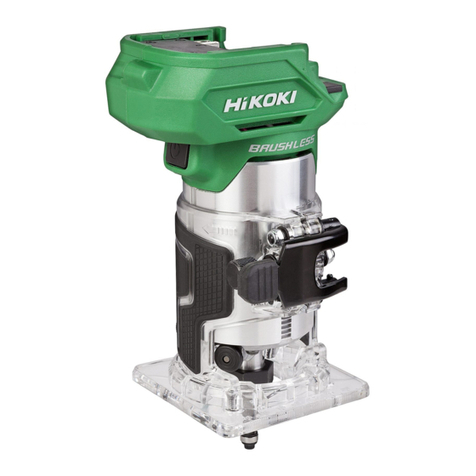
HIKOKI
HIKOKI M1808DA User manual
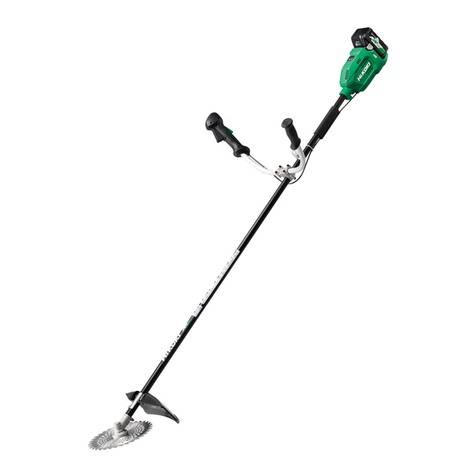
HIKOKI
HIKOKI CG 36DC User manual
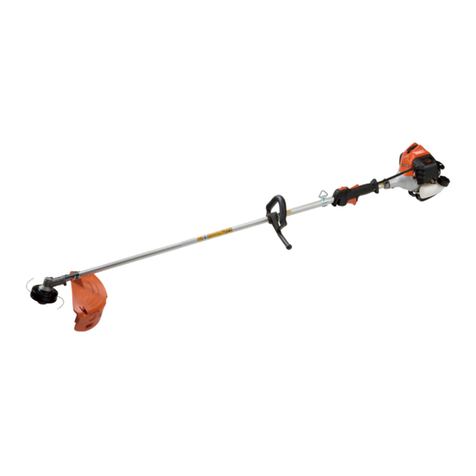
HIKOKI
HIKOKI CG 24EBS(SL) User manual

HIKOKI
HIKOKI CH 3656DA User manual
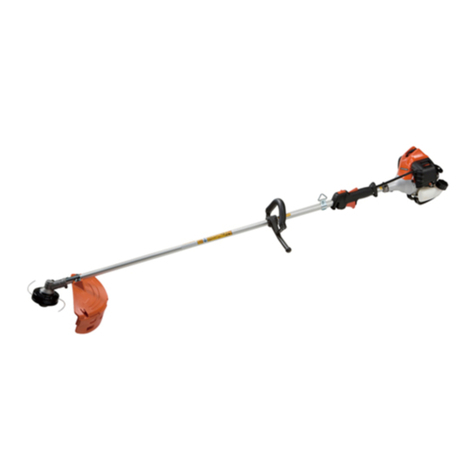
HIKOKI
HIKOKI CG24EBSP User manual

HIKOKI
HIKOKI CH 24EAP User manual
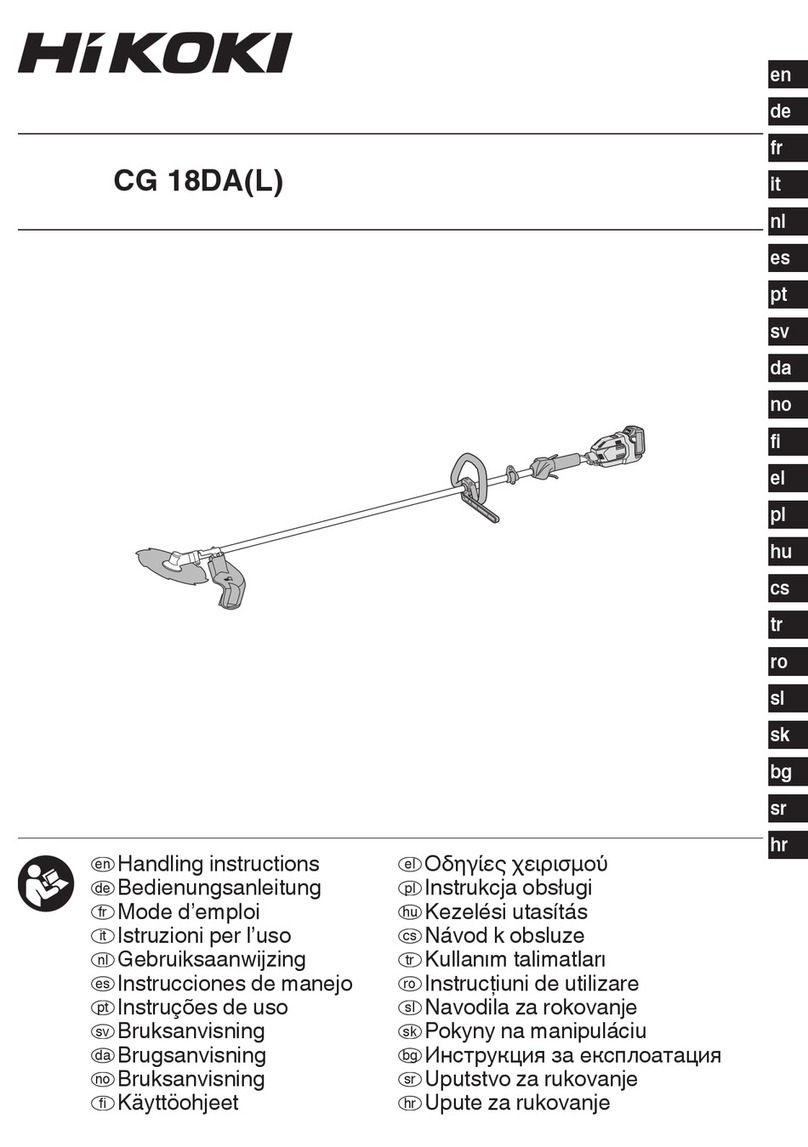
HIKOKI
HIKOKI CG 18DA User manual

HIKOKI
HIKOKI CH 45Y User manual

HIKOKI
HIKOKI CG 24ECP User manual

HIKOKI
HIKOKI CG 24EBSP (SL) User manual
